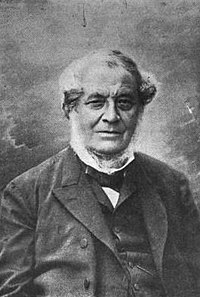 |
| Robert Wilhelm Bunsen |
Robert Wilhelm Eberhard Bunsen (30 March 1811 – 16 August 1899) was aGerman chemist. He investigated emission spectra of heated elements, and withGustav Kirchhoff discovered caesium (in 1860) and rubidium (in 1861). Bunsen developed several gas-analytical methods, was a pioneer in photochemistry, and did early work in the field of organoarsenic chemistry. With his laboratory assistant, Peter Desaga, he developed the Bunsen burner, an improvement on the laboratory burners then in use. The Bunsen–Kirchhoff Award for spectroscopy is named after Bunsen and Kirchhoff. The Robert Wilhelm Bunsen Medal is assigned every year by the European Geosciences Union (www.egu.eu) to scientists who provided significant advance in the fields of Geochemistry, Mineralogy, Petrology, and Volcanology.
Bunsen was born in Göttingen, Germany, the youngest of four sons of theUniversity of Göttingen's chief librarian and professor of modern philology, Christian Bunsen (1770–1837). After attending school in Holzminden, in 1828 Bunsen matriculated at Göttingen and studied chemistry with Friedrich Stromeyer, obtaining the Ph.D. degree in 1831. In 1832 and 1833 he traveled in Germany, France, and Austria, where he met Friedrich Runge (who discoveredaniline and in 1819 isolated caffeine), Justus von Liebig in Gießen, and Eilhard Mitscherlich in Bonn.
University teacher
In 1833, Bunsen became a lecturer at Göttingen and began experimental studies of the (in)solubility of metal salts of arsenous acid. Today, his discovery of the use of iron oxide hydrate as a precipitating agent is still the best-knownantidote against arsenic poisoning. In 1836, Bunsen succeeded Friedrich Wöhler at the Polytechnic School of Kassel. Bunsen taught there for three years, and then accepted an associate professorship at theUniversity of Marburg, where he continued his studies on cacodyl derivatives. He was promoted to full professorship in 1841. Bunsen's work brought him quick and wide acclaim, partly because cacodyl, which is extremely toxic and undergoes spontaneous combustion in dry air, is so difficult to work with. Bunsen almost died from arsenic poisoning, and an explosion with cacodyl cost him sight in his right eye. In 1841, Bunsen created the Bunsen cell battery, using a carbonelectrode instead of the expensive platinum electrode used in William Robert Grove's electrochemical cell. Early in 1851 he accepted a professorship at theUniversity of Breslau, where he taught for three semesters.
In late 1852 Bunsen became the successor of Leopold Gmelin at theUniversity of Heidelberg. There he usedelectrolysis to produce pure metals, such as chromium, magnesium,aluminium, manganese, sodium,barium, calcium and lithium. A long collaboration with Henry Enfield Roscoe began in 1852, in which they studied the photochemical formation of hydrogen chloride from hydrogen andchlorine.
Bunsen discontinued his work with Roscoe in 1859 and joined Gustav Kirchhoff to study emission spectra of heated elements, a research area called spectrum analysis. For this work, Bunsen and his laboratory assistant, Peter Desaga, had perfected a special gas burner by 1855, influenced by earlier models. The newer design of Bunsen and Desaga, which provided a very hot and clean flame, is now called simply the "Bunsen burner".
There had been earlier studies of the characteristic colors of heated elements, but nothing systematic. In the summer of 1859, Kirchhoff suggested to Bunsen that he try to form prismatic spectra of these colors. By October of that year the two scientists had invented an appropriate instrument, a prototype spectroscope. Using it, they were able to identify the characteristic spectra of sodium, lithium, and potassium. After numerous laborious purifications, Bunsen proved that highly pure samples gave unique spectra. In the course of this work, Bunsen detected previously unknown new blue spectral emission lines in samples of mineral water from Duerkheim, Germany. He guessed that these lines indicated the existence of an undiscovered chemical element. After careful distillation of forty tons of this water, in the spring of 1860 he was able to isolate 17 grams of a new element. He named the element "caesium", after the Latin word for deep blue. The following year he discovered rubidium, by a similar process.
In 1860, he was elected a foreign member of the Royal Swedish Academy of Sciences.
Personality And Biography Summary and Achiements
When Bunsen retired at the age of 78, he shifted his work solely to geology and mineralogy, an interest which he had pursued throughout his career. He died in Heidelberg aged 88.
| Born | 30 March 1811 Göttingen, Kingdom of Hanover, Germany |
|---|---|
| Died | 16 August 1899 (aged 88) Heidelberg, GermanywdJHDIJW]RW |
| Residence | Germany |
| Nationality | German |
| Fields | Chemistry |
| Institutions | Polytechnic School of Kassel University of Marburg University of Heidelberg University of Breslau |
| Alma mater | University of Göttingen |
| Doctoral advisor | Friedrich Stromeyer |
| Doctoral students | Adolf von Baeyer Francis Robert JappFritz Haber Philipp Lenard Georg Ludwig Carius Hermann Kolbe Adolf Lieben Carl Friedrich Wilhelm Ludwig Viktor Meyer Friedrich Konrad Beilstein Henry Enfield Roscoe John Tyndall Edward Frankland Dmitri Mendeleev Thomas Edward Thorpe |
| Known for | Discovery of cacodyl radical; discoveries of caesium and rubidium; invention of theBunsen burner; carbon-zinc electrochemical cell; methods of gas analysis; development of spectrochemical analysis |
| Notable awards | Copley medal (1860) |



 Posted in:
Posted in: 



